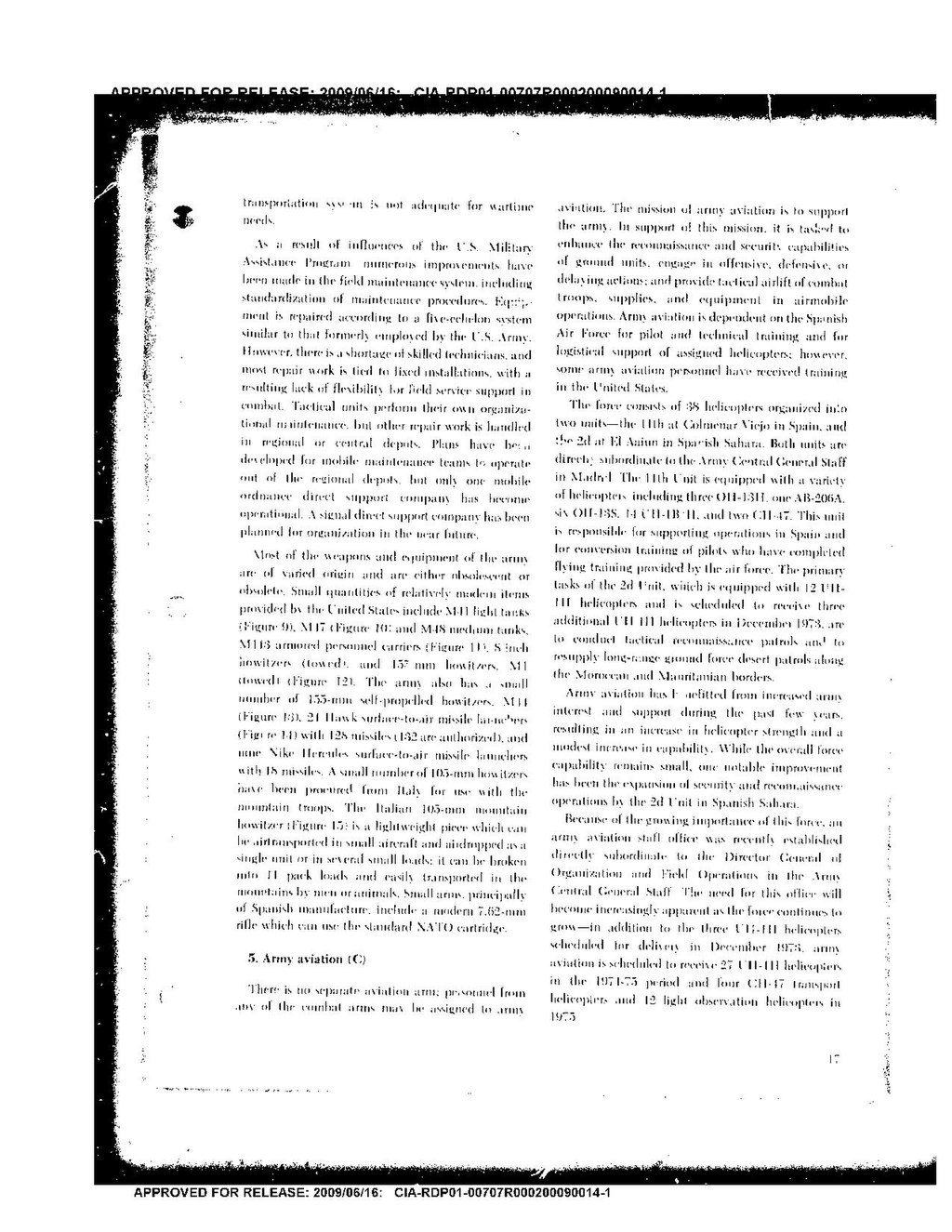APPROVED FOR RELEASE: 2009/06/16: CIA-RDP01-00707R000200090014-1
transportation system is not adequate for wartime needs.
As a result of influences of the US Military Assistance Program, numerous improvements have been made in the field maintenance system, including standardization of maintenance procedures. Equipment is repaired according to a five-echelon system similar to that formerly employed by the US Army. However, there is a shortage of skilled technicians, and most repair work is tied to fixed installations, with a resulting lack of flexibility for field service support in combat. Tactical units perform their own organizational maintenance, but other repair work is handled in regional or central depots. Plans have been developed for mobile maintenance teams to operate out of the regional depots, but only one mobile ordnance direct support company has become operational. A signal direct support company has been planned for organization in the near future.
Most of the weapons and equipment of the army are of varied origin and are either obsolescent or obsolete. Small quantities of relatively modern items provided by the United States include M41 light tanks, M47 and M48 medium tanks, M113 armored personnel carriers, 8-inch howitzers (towed), and 155 mm howitzers, M1 (towed). The army also has a small number of 155-mm self-propelled howitzers, M44, 24 Hawk surface-to-air missile launchers with 128 missiles (132 are authorized), and nine Nike Hercules surface-to-air missile launchers with 18 missiles. A small number of 105-mm howitzers have been procured from Italy for use with the mountain troops. The Italian 105-mm mountain howitzer is a lightweight piece which can be air-transported in small aircraft and air-dropped as a single unit or in several small loads; it can be broken into 11 pack loads and easily transported in the mountains by men or animals. Small arms, principally of Spanish manufacture, include a modern 7.62-mm rifle which can use the standard NATO cartridge.
5. Army aviation (C)
There is no separate aviation army personnel from any of the combat arms may be assigned to army aviation. The mission of army aviation is to support the army. In support of this mission, it is tasked to enhance the reconnaissance and security capabilities of ground units; engage in offensive, defense, or delaying actions; and provide tactical airlift of combat troops, supplies, and equipment in airmobile operations. Army aviation is dependent on the Spanish Air Force for pilot and technical training and for logistical support of assigned helicopters; however, some army aviation personnel have received training in the United States.
The force consists of 38 helicopters organized into two units - the 11th at Colmenar Viejo in Spain, and the 2nd at El Aaiun in Spanish Sahara. Both units are directly subordinate to the Army Central General Staff in Madrid. The 11th Unit is equipped with a variety of helicopters, including three OH-13H, one AB-206A, six OH-13S, 14 UH-1B/H, and two CH-47. This unit is responsible for supporting operations in Spain and for conversion training of pilots who have completed flying training provided by the air force. The primary tasks of the 2nd Unit, which is equipped with 12 UH-1H helicopters and is scheduled to receive three additional UH-1H helicopters in December 1973, are to conduct tactical reconnaissance patrols and to resupply long-range ground force desert patrols along the Moroccan and Mauritanian borders.
Army aviation has benefitted from increased army interest and support during the past few years, resulting in an increase in helicopter strength and a modest increase in capability. While the overall force capability remains small, one notable improvement has been the expansion of security and reconnaissance operations by the 2nd Unit in Spanish Sahara.
Because of the growing importance of this force, an army aviation staff office was recently established directly subordinate to the Director General of Organization and Field Operations in the Army Central General Staff. The need for this office will become increasingly apparent as the force continues to grow - in addition to the three UH-1H helicopters scheduled for delivery in December 1973, army aviation is scheduled to receive 27 UH-1H helicopters in the 1974-1975 period and four CH-47 transport helicopters and 12 light observation helicopters in 1975.
17
APPROVED FOR RELEASE: 2009/06/16: CIA-RDP01-00707R000200090014-1
